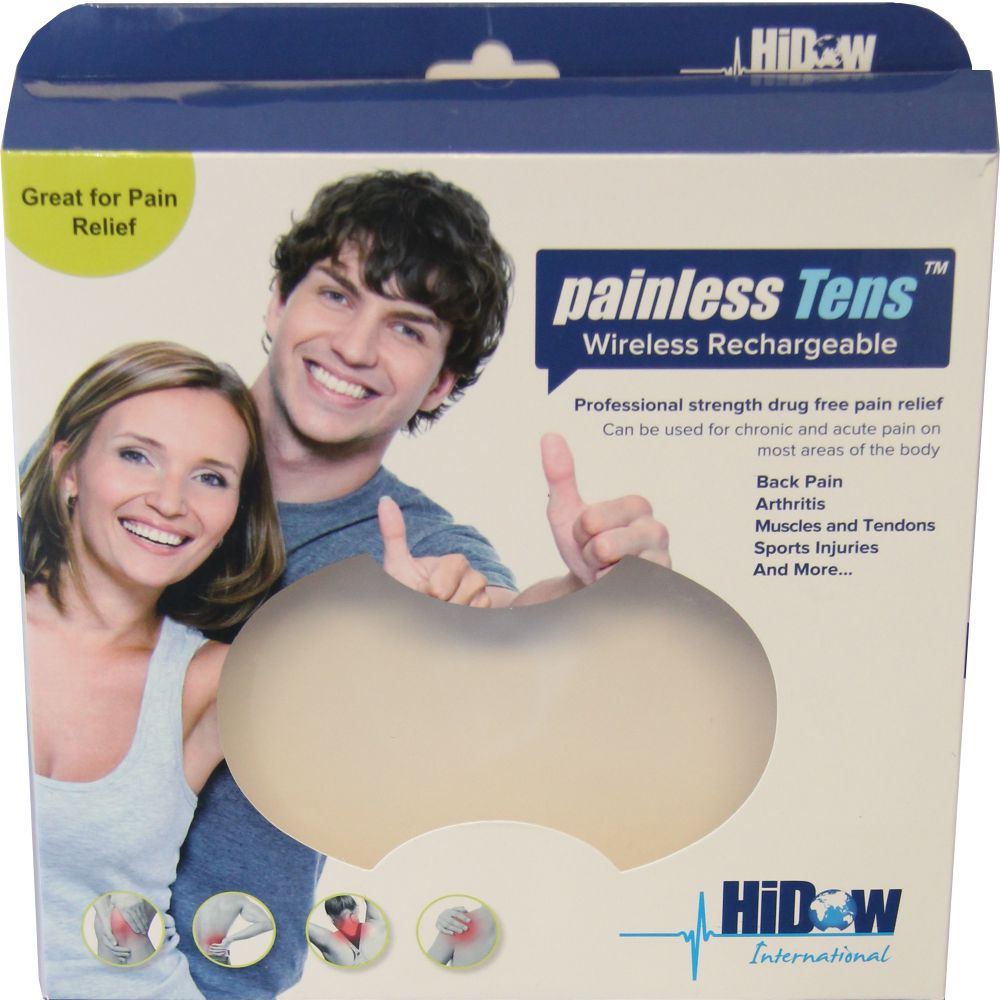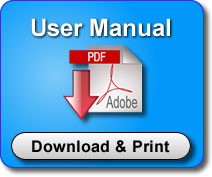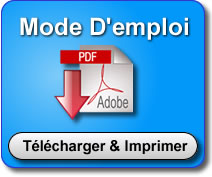Painless TENS
The wireless PAINLESS TENS is a single-channel transcutaneous electrical nerve stimulator (TENS) for over-the-counter (No prescription is required) use of pain relief.
The device generates small pulses of electrical current and delivers the pulses to the user’s skin through adhesive gel electrode pads such that the underlying nerves are activated and the pain associated with sore and aching muscles is relieved.
The PAINLESS TENS is portable, compact, rechargeable and stylish in design. It may help relieve pain in various areas of body, such as the lower back, shoulders, arms and legs.
Downloads
TENS/EMS Information
For some people, a transcutaneous electrical nerve stimulation (TENS) machine is used as an alternative to painkilling medication. A TENS machine is a small portable, battery-operated device which is worn on the body. The box is attached by wires to sticky pads stuck to the skin.
Small electrical pulses are transmitted to the body, like little electric shocks. This can help to ease pain in some people with certain types of pain. Although there is not much robust proof that TENS machines work, many people do find them very helpful. The advantage is that TENS is well tolerated and largely without side-effects.
How effective are TENS machines?
Research trials looking at the effectiveness of TENS machines have so far been inconclusive. Further large studies are needed to clarify the precise role and effect of using TENS.
However, TENS machines have proved to be a popular form of pain relief with some people. As with many forms of treatment, the effect can vary from individual to individual, even with the same condition.
How do TENS machines work?
Transcutaneous means through the skin. TENS machines deliver small electrical pulses to the body via electrodes placed on the skin. TENS machines are thought to affect the way pain signals are sent to the brain.
Pain signals reach the brain via nerves and the spinal cord. If pain signals can be blocked by the tiny electrical shocks from the TENS machine, then the brain will receive fewer signals from the source of the pain.
TENS machines are thought to work in two ways
- On a high pulse rate of 90-130 Hz (the normal method of use), the electrical impulses generated by the TENS machine interfere with and block pain messages sent to the brain. This is due to the gate control theory of pain. This proposes that there is a gate mechanism in the central nervous system (the brain and spinal cord nerves). When the gate is open, pain messages get through to the brain, and we feel pain. When the gate is closed, these pain messages are blocked and we do not feel pain. TENS machines are thought to stimulate certain non-pain-carrying nerves and close the gate. In effect, the brain is busy dealing with the messages it receives quickly from the TENS machine, rather than the slower (more painful) pain signals that the body is receiving from elsewhere. It explains why, if you injure yourself, rubbing that area can temporarily reduce the pain.
- When the machine is set on a low pulse rate (2-5 Hz) it stimulates the body to make its own pain-easing chemicals called endorphins. These act a bit like morphine to block pain signals.
How are TENS machines used, and by whom?
It is best to use a TENS machine only on the advice of a doctor or other health professional. They are not suitable for all types of pain or all conditions.
A TENS machine is personally controlled by the user. This means its settings can be adjusted, without having to visit a medical professional. Typically, a machine would be used for 15-20 minutes per session, several times per day. See below for specific instructions.
TENS machines are most commonly used for people with musculoskeletal pain, such as chronic (long-term) back pain or knee joint arthritis. They are also often used for pain relief in the early stages of labour, particularly whilst a pregnant woman remains at home.
Other less common uses include migraine headaches, period pains, sports injuries and sometimes (quite rarely) non-painful conditions such as tiredness, insomnia or dementia.
TENS machines can be used alone for pain relief, or be combined with other treatments. The use of a TENS machine might allow reduction of the amount of painkilling medicines you take. Although you might need to try a few settings on your TENS machine before finding the best one for you, there are no real side-effects from using a TENS machine.
A TENS machine might be worth a trial, particularly if conventional pain relief methods have been tried and exhausted. Importantly, TENS machines can be expensive. It is probably best if you hire or borrow one first, to try it out.
If you plan to try TENS in labour, your midwife or local National Childbirth Trust (NCT) branch should be able to locate one to rent. If you are new to using a TENS machine, take things slowly, even if you are finding it useful. Don't try to do too much too soon (as you may hurt yourself and make the pain worse) and don't stop all of your normal painkilling medication too quickly. If you are on either a lot of strong painkillers or a number of different ones, it might be worth consulting your doctor for advice on how to reduce them safely, with minimal side-effects.
Can TENS machines be used by everybody?
TENS machines tend to be mainly used to help reduce pain associated with problems in muscles, joints and nerves (so-called musculoskeletal pain) rather than abdominal, chest or head pains. Unlike a lot of medication there are virtually no side-effects when using a TENS machine.
People with the following must not use a TENS machine:
- When the cause of the pain is not known or is not diagnosed.
- Pregnancy (unless specifically medically advised - or in labour).
- Pacemakers.
- Epilepsy or certain types of heart disease
Instructions
Instructions for using a TENS machine?
There are various types and brands of machine. Always follow the manufacturer's instructions supplied with your machine.
Some general points:
- TENS machines are designed so that you can move around with them working. You can tuck the machine into a pocket or clip it on to a belt.
- Before placing the electrode pads on the skin make sure the machine is switched off.
- Test the machine by holding the pads between the fingers and then carefully turn it on. You should feel a tingling sensation.
- Make sure the skin where the pads are applied is clean and dry and there are no cuts, grazes or areas of skin irritation.
- Place the pads either side of the pain. Use either self-adhesive pads or flexible rubber pads which should be completely covered, on the surface to be applied to the skin, with a thin layer of conductive gel. The pads should not be put within an inch (2-3 cm) of each other. Your physiotherapist or doctor will show you where to put the pads.
- Fix the pads to the skin with tape if you intend moving around.
- Set the pulse rate to the required setting (about 100 Hz is about right to start with).
- Switch on the machine slowly and turn it up gradually until you feel a tingling sensation. The sensation needs to be quite strong but not uncomfortable. After a few minutes the sensation will start to drop away slightly. This is called accommodation. When this happens, turn the machine up slightly and then leave it for the rest of the time in use. Do not turn it up too high, as this can cause over-stimulation which may make pain worse. There should be no muscle contraction.
- At the end of the session turn the machine off and disconnect the electrodes from the machine. If you intend using TENS again later there is no need to remove the electrode pads from the skin. Simply tuck the wires out of the way and carry on as normal.
- Check that the pads or tape do not irritate the skin. If the skin is red you may need to use a different type of pad, contact gel or tape.
- The machine should be used for at least 45 minutes but can be used for up to 12 hours before the electrodes need to be cleaned and re- sited.
- When you have finished using the machine for the day, carefully remove the pads from the skin and clean the skin with ordinary soap and water. Do not pull directly on the wires to remove the pads. If there is any redness or irritation from the pads or tape then the next time you use the machine use a different area of skin.
- If you use rubber pads, clean off the conducting gel with mild soap and water and rinse them well. Do not wash the self-adhesive type of pad.
Cautions when using a TENS machine
- Do not place electrode pads on broken or damaged skin.
- Do not place electrode pads over the front or side of the neck, close to eyes or in the mouth.
- Do not use over areas of reduced sensation.
- Do not use near water such as in the bath or shower.
- Do not use when driving or operating machinery.









